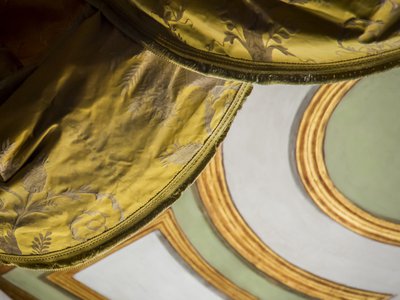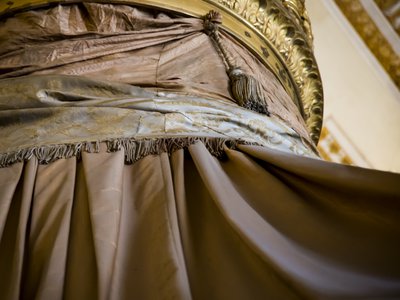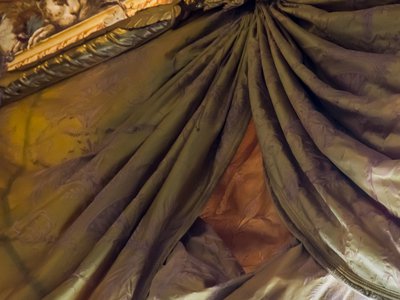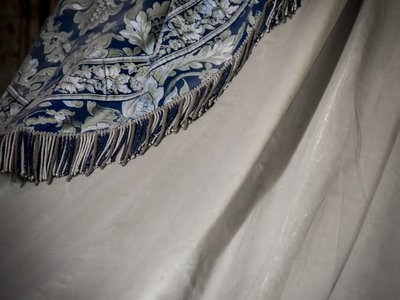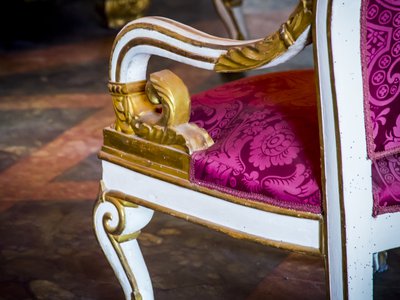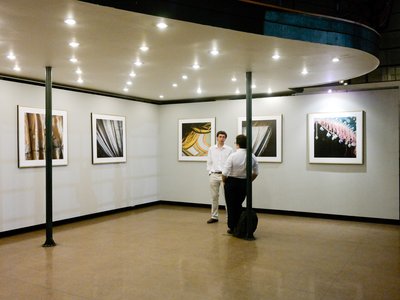Anonimata /Anonimata
Estas telas son realmente antiguas. Tienen, a lo menos 200 años. Están ajadas, rotas, pero, aún guardan parte del resplandor y la prestancia que alguna vez ostentaron. Me recuerdan los brillos y la textura de los fondos y brocados de utilería, clásicos de la pintura. Cuando tomé estas fotos, no pude dejar de comparar las telas, como una metáfora del ocultamiento de las mujeres en la historia del arte. Desde siempre el trabajo y la obra artística femenina ha estado tras bambalinas. Han sido dejados detrás, cual escenografía, fuera del gran retratado de todos los tiempos: los hombres artistas. Muchos estudios de Historia del Arte desde comienzos de los años 70, han empezado a desenterrar la obra de artistas en Occidente, que han caído en el olvido de manera injusta por el simple hecho de ser mujeres. La ausencia de referencias femeninas, no sólo en la literatura o en pintura, sino también en la filosofía, la arquitectura o incluso en las artes decorativas, nos ha hecho creer que las mujeres artistas han sido escasas o que no han existido. Sin embargo, en 1985, Chris Petteys había recopilado en su diccionario entradas de 21 mil mujeres artistas nacidas antes de 1900. Esto demuestra que la concepción que tenemos con respecto a la omisión de las mujeres en la historia del arte, está equivocada. Sí existieron, fueron relevantes, fueron conocidas y fueron olvidadas, muchas incluso tuvieron que ver cómo sus obras eran atribuidas a sus padres o maridos.
Las mujeres artistas han trabajado siempre en condiciones muy difíciles. Vivieron apartadas durante mucho tiempo de los mejores centros de enseñanza artística, sometidas a las presiones de la sociedad, obligadas a compatibilizar su trabajo con sus deberes como esposas, madres o hijas y a veces, incluso, condenadas a trabajar con peores materiales, porque se les pagaba menos que a los hombres. No es verdad que las mujeres no existieron en la historia del arte: fueron menos que los hombres, pero más de las que aparecen en los libros. Un ejemplo de esto es Ende, pintora que iluminaba códices durante el siglo X. Sus miniaturas están llenas de simbolismo. Durante muchos años, su obra se atribuyó a un hombre, pero su firma en el manuscrito del Beatus del Apocalipsis, conservado en Gerona dicta “Ende pintrix et Dei aiutrix”, que significa “Ende, pintora y sierva de Dios”. Otro caso es el de Marianne, quien fue una compositora del siglo XVI. Ella es más conocida por ser la hermana mayor de Wolfgang Amadeus Mozart. De su trabajo no quedan copias. Vemos en las cartas escritas por su hermano, como él alaba su obra musical. Se presentaba junto a Wolfgang hasta que en 1769 su padre le prohibió seguir seguir interpretando música públicamente, porque a los 18 años ya estaba en edad de contraer matrimonio.
Las mujeres del Dadá son otras de las grandes olvidadas del siglo XX. Raramente se las menciona, y si se hace, es en relación con sus compañeros sentimentales y nunca como artistas con talento propio. Así, por ejemplo, cuando se habla de Hans Arp, se habla poco de su mujer, Sophie Taeuber Arp, a pesar de ser una parte imprescindible de su obra, pues ambos trabajaron durante muchos años en obras conjuntas. Hans Arp introdujo a Taeuber al círculo Dadá, pero antes de eso ella ya era creadora y contaba con esas características de libertad de creación tan típicas del círculo de Zurich. Sabemos que ella llevaba la creatividad a todas las ramas posibles, desde el diseño textil, creando sus propias ropas, pasando por la danza, las marionetas, la pintura, la escultura e incluso al diseño de interiores. Judy Chicago trabaja está problemática de la mujer representada, pero ausente, en su obra “The Dinner Party”. Esta obra es una mesa gigante, con forma de triángulo, donde coloca un puesto diseñado especialmente para 39 mujeres míticas e históricas: Sacajawea, Sojourner Truth, Eleanor of Aquitaine, Empress Theodora of Byzantium, Virginia Woolf, Susan B. Anthony, and Georgia O'Keeffe entre otras. Esta serie que presento es una alegoría al destierro, la indiferencia y la desafectación, que han sufrido las mujeres artistas. Usando objetos cotidianos como estas decoraciones, pretendo hacer visible esta postergación. Las fotografías rescatan justamente lo que nadie mira: el detalle del decorado. Ponen como protagonistas a estos géneros, que a su vez, simbolizan al género olvidado: a nosotras.
These fabrics are really old. They are at least 200 years old. They are worn out, broken, but they still retain part of the radiance and elegance that they once had. They remind me of the shine and texture of the backgrounds and brocades of the props used in classic painting. When I took these photos, I couldn't help but compare the fabrics, as a metaphor for the concealment of women in art history. Women's artistic work has always been behind the scenes. They have been left behind, like scenery, outside the great portrait of all time: the male artists. Many Art History studies since the early 1970s have begun to unearth the work of female artists in the West who have been unfairly forgotten for the simple fact of being women. The absence of female references, not only in literature or painting, but also in philosophy, architecture or even in the decorative arts, has led us to believe that women artists have been rare or have not existed. However, in 1985, Chris Petteys compiled his dictionary entries of 21 thousand women artists born before 1900. This shows that the conception we have regarding the omission of women in the history of art is wrong. Yes, they existed, they were relevant, they were known and they were forgotten, many even had to witness how their works were attributed to their fathers or husbands. Women artists have always worked in very difficult conditions.
Women were not aloud for a long time to access the best centers of artistic education, subjected to the pressures of society, forced to combine their work with their duties as wives, mothers or daughters and sometimes even condemned to work with worse materials, because they were I paid less than men. It is not true that women did not exist in the history of art: they were fewer than men, but more than those who appear in books. An example of this is Ende, a painter who illuminated codices during the 10th century. Her miniatures are full of symbolism. For many years, her work was attributed to a man, but her signature on the manuscript of the Beatus of the Apocalypse, preserved in Gerona, dictates “Ende pintrix et Dei aiutrix”, which means “Ende, painter and servant of God”. Another case is Marianne, who was a composer of the 16th century. She is best known for being the older sister of Wolfgang Amadeus Mozart. There are no copies left of her work. We see in the letters written by his brother, how he praises her talent. She performed alongside Wolfgang until 1769 when her father forbade her to continue performing music publicly, because at the age of 18 she was ready to be marriage.
The women of Dada are other of the great forgotten women of the 20th century. They are rarely mentioned, and if ithey are, it is in relation to their romantic partners and never as artists with their own talent. Thus, for example, when talking about Hans Arp, little is said about his wife, Sophie Taeuber Arp, despite being an essential part of his work, since both worked for many years on joint endevours. Hans Arp introduced Taeuber to the Dada circle, but before that she was already a creator on her own right. We know that she demostrated her creativity from textile design, creating her own clothes, through dance, puppets, painting, sculpture and even interior design. Judy Chicago works on the issue of women absence, in her work “The Dinner Party.” This work is a giant table, shaped like a triangle, where there is a stand specially designed for 39 mythical and historical women: Sacajawea, Sojourner Truth, Eleanor of Aquitaine, Empress Theodora of Byzantium, Virginia Woolf, Susan B. Anthony, and Georgia O 'Keeffe among others.
This series that I present is an allegory to the exile, indifference and disaffection that women artists have suffered. Using everyday objects like these decorations, I aim to make this problem visible. The photographs rescue precisely what no one sees: the detail of the decoration. They symbolize the forgotten gender: us.
FICHA TÉCNICA
Fotografía digital, impresa sobre Glicée, 80 cm x 80 cm, 2017.
Expuesto en la sala Lily Garafullic del Centro Cultural Estación Mapocho, 2018.
Digital photography, Glicée print, 80 cm x 80 cm, 2017.
Exhibited in Lily Garafullic gallery, Centro Cultural Estación Mapocho, 2018.
https://www.estacionmapocho.cl/wp-content/uploads/2019/01/MEMORIA-CCEM-2018-Baja-1.pdf
